10 Best Movie Musicals
Few people remember those days, but in the good old days of Hollywood, musicals were the genre that enjoyed the greatest success. Today, this type of film is no longer as popular or interesting. Like the western, for example, it is considered a relic of the past. If a contemporary musical is made, it generates a lot of hype, as was the case with “La La Land,” a production enthusiastically received by critics and audiences alike. It is a musical for our times, in which the leading roles were given to actors who are not particularly skilled at singing or dancing. In the past, however, musicals offered entertainment of the highest order, and their stars were true virtuosos of the stage. Musicals have left a lasting mark on the history of cinema, serving as a gateway to the magical world of film. Here are my picks for the top 10 works in this genre.
10 best musicals
10. “Fame” (1980)
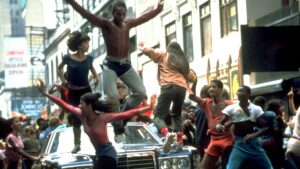
Film dancing and singing seem to be the domain of young people. “Fame” is a story about them. It is a work that existed in two forms. On the one hand, it was a television series, and on the other, a feature film. Admittedly, the series made more sense, but the film also presented a certain level of quality that predisposes it to a place in this list. The film tells the story of students at a New York art school specializing in singing, dancing, acting, and playing instruments. The production was a hit, which led to the creation of a TV series. One could get the impression that the series came first, as the narrative of the film version lacked fluidity.
Nevertheless, it is still great entertainment, with memorable, distinctive numbers, led by the title hit performed by Irene Cary. “Fame” stands out mainly for the great spontaneity of the actors, who exude youthful energy on screen. Their choral singing and dancing have always impressed me. Despite their apparent chaos, their dance routines showcase their full talent. Some of the scenes were improvised and the songs were recorded live, which adds to the authenticity and naturalness of the production. Its main strength is not the content itself, but the form presented against the backdrop of a dirty, tired, and ruined city.
9. “Tommy” (1975)
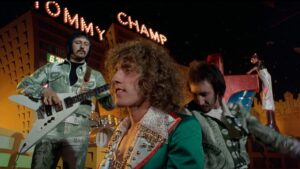
When you want to make a good musical, it seems like a good idea to give the lead role to someone for whom singing is second nature. In the case of “Tommy,” this role is played by Roger Daltrey, the lead singer of the legendary British band The Who. The choice of this particular singer was obvious, as the film is based on the band’s album. In Ken Russell’s film, he plays the title character, a young man who loses his sight, hearing, and speech as a result of dramatic events in his childhood. In addition to Daltrey, the film also features other professional musicians such as Tina Turner, Eric Clapton, and Elton John. The latter is particularly memorable for his daring performance of “Pinball Wizard.”
The entire production is carried out on a grand scale. The lion’s share of the plot is told through songs. As in other works by the English director, the set design plays an important role here. It creates a surreal impression, turning the film into an unforgettable journey into a world of musical, extravagant fantasies.
8. “The Court Jester” (1955)
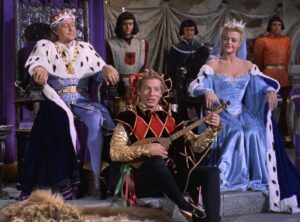
And now a tribute to old Hollywood. There was a time when musicals were at their peak, and films of this genre regularly competed for Oscars. This was in the post-war years, and productions from this period were often shown on our television on special occasions. It was a real celebration of cinema, eagerly awaited all week long. It was often preceded by a lecture encouraging viewers to see the film. One such film is “The Court Jester” from 1955. This film is a showcase for one actor: Danny Kaye. This artist of Polish descent was at the height of his popularity at the time. He was able to completely steal the show, being the central figure in many productions. These are now part of the canon of the genre, and Kaye is one of the many stars of that distant era.
The same is true of “The Court Jester.” This comedy of errors is the perfect opportunity for the actor to showcase his many talents. The artists of the time, led by Kaye, were true athletes. Their gymnastic feats would have been the envy of Jackie Chan himself. They were people made for musicals, able to use their bodies as a medium of expression, which they had mastered to perfection.
7. “The Wayward Cloud” (“Tian bian yi duo yun”, 2005)
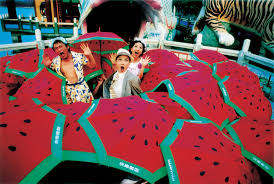
And now something completely different. Specifically, something from Asia. “The Wayward Cloud” is a Taiwanese film that focuses on the process of making pornographic films. Admittedly, this is an unusual subject for a musical. However, there is method in this madness. It is a completely different experience from the Hollywood productions we are used to seeing every day. The musical and dance sequences are quite impressive. They have an absurd style. They are full of spectacular combinations and transitions involving large groups of dancers.
This work is a real rollercoaster ride and a treat for viewers looking for unconventional solutions in cinema. It may not have any particular memorable compositions, but it certainly provides a lot of excitement. It should be approached with a sense of distance and an open mind. After all, different countries have different customs.
6. “All That Jazz” (1979)
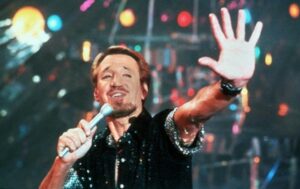
If you’re going to make a musical, it’s best to make it about people in the industry. This was probably the premise behind the creators of “All That Jazz”. It is loosely based on the experiences of the film’s co-writer. It depicts the life of a renowned dancer and choreographer under constant professional and personal pressure, fueled by numerous addictions. Roy Scheider plays the lead role. I must admit that I don’t think he’s entirely suited to the part. I can’t really see him in a musical, and dressed in sequins with a small moustache, he looks downright grotesque.
Fortunately, he speaks more than he sings in the film. This aspect was left to true professionals, which is its strength. It may have some flaws in terms of plot, but the dance sequences are really top-notch. It is an insider’s look at the artistic community, showing the hardships, ups and downs of the profession. It is thanks to such images that one can realize how hard and demanding the work of a stage artist can be and how much sacrifice it requires.
5. “Cabaret” (1972)
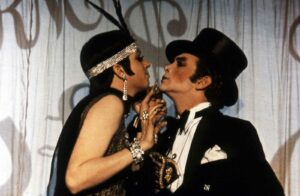
When I was a child, my mother used to praise certain films, telling me about the iconic scenes they contained. One such scene comes from the film “Cabaret.” It is the moment when, at a country picnic in Nazi Germany, a group of civilians begin to sing the song “Tomorrow Belongs to Me.” What starts as a solo performance quickly turns into a chorus of voices. This was meant to show the fanaticism and unity of the German people shortly before the outbreak of war. However, this is not the only memorable part of the film. Like any good musical, it contains many wonderful songs, including “Money, Money.” They are perfectly combined with dance sequences.
The film draws maximum meaning from the fact that its protagonists are stage artists. At the same time, it has a bittersweet tone, resulting from the story of difficult times. The backdrop for the events is one of the darkest periods in the history of the 20th century. The cabaret performers try to keep a smile on their faces despite everything, but they are aware of the horror that is fast approaching.
4. “The Rocky Horror Picture Show” (1975)
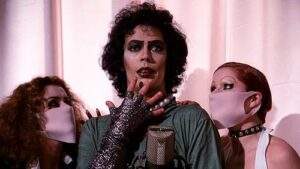
One of the earlier entries on the list was Alan Parker’s “Fame”. This film includes a scene in which a couple goes to see “The Rocky Horror Picture Show”. During the screening, we see that some of the audience is dressed up as characters from the film and sings along to all the songs. As you can see, just five years after its release, the production gained a loyal fan base and achieved cult status. It is still perceived that way today. “The Rocky Horror Picture Show” is a work that perfectly fits the description “crazy.”
It is an explosive mixture of classic gothic horror with cabaret and the debauchery brought about by the sexual revolution. The musical remains a guilty pleasure for many people, especially those whose sexual orientation remains undefined. The whole thing is kept in a humorous, cheerful tone, and the individual songs, led by “Sweet Transvestite,” are very catchy and impress with their witty lyrics.
3. “The Wizard of Oz” (1939)
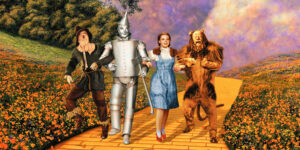
The podium of the best musicals is opened by the oldest entry on the list, “The Wizard of Oz.” The film premiered in 1939. When you watch it knowing that war broke out that year, you experience a strange feeling of dissonance. Although I remember “The Wizard of Oz” from my childhood, it was only as an adult that I fully appreciated it. What appeals to me most is its incredible, fairy-tale atmosphere. Especially the second half of the film, when the characters enter the evil witch’s territory, has a gloomy and dark glow. And the march of the flying monkeys still makes an ominous impression today.
However, the other numbers in the production are in no way inferior in quality. The film contains many memorable moments. The most famous song is, of course, “Over the Rainbow” performed by Judy Garland. It became her signature song and the musical’s showstopper. Its tone is much lighter than the original, making the production suitable for younger audiences. It can serve as wonderful family entertainment. Despite the passing of years, it still delights with its magical scenery and overall color.
2. “Fiddler on the Roof” (1971)
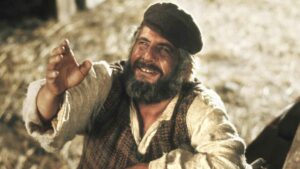
Not every musical has to be about the lives of artists. In fact, it can be about anything. In the case of “Fiddler on the Roof”, it is the saga of a Jewish family living in Tsarist Russia. The head of the family has three daughters to marry off. Each of them finds a partner, but not always in accordance with their parents’ wishes. This film is one of the most famous musicals ever made. Its fame is well deserved. It does not have a single weak element. The casting is perfect, the characters are colorful and distinctive. The background of the events is deeply rooted in tradition and the geopolitical situation, which gives the work depth. However, the most important thing here is the songs. Of course, everyone knows the number “If I Were a Rich Man,” but my favorites are ‘Tradition’ and “Miracle of Miracles.” When I watched musicals as a child, I often got bored and treated the musical numbers as a necessary evil. Many of them just seemed terribly long to me. However, this was never the case with “Fiddler on the Roof.”
Each song is unique and tells its own story. They vary in tone and are an integral part of the plot. They often take the form of a dialogue between several characters, which engages the audience’s attention. And I remember them all. I even had a cassette tape with songs from this musical. For me, it remains a vibrant example of musical cinema, capable of evoking the right emotions through music. At the same time, it is an incredible lesson in history and tradition, much of which has already been forgotten.
1. “Singin’ in the Rain” (1952)
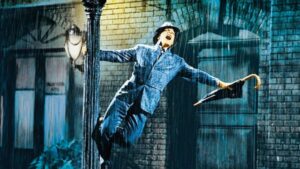
Only one film can occupy the honorable first place in the ranking. I am talking about “Singin’ in the Rain”. I have seen this film many times and it has always given me a lot of pleasure. At first, it was just one of those musicals my parents talked about, but as I grew older, I noticed its phenomenon and became a fan, appreciating its quality. The strength of “Singin’ in the Rain” lies primarily in its cast, led by Gene Kelly. I have never seen a better dancer on screen, and when you add his velvety voice to that, you have true perfection. Kelly, of course, starred in many musicals, such as “An American in Paris.” For me, however, “Singin’ in the Rain” holds the palm, serving as a benchmark for all other productions. This film has something that others often lack. It simply has soul. It radiates a magical glow and draws the viewer into its dancing world, vibrating with positive energy.
For the characters in the movie, nothing is impossible. If necessary, they will dance on the wall or ceiling. The artists performing here are true athletes and masters of their craft. Suffice it to say that another of my favorites appears among them, Cyd Charisse, who could share her sex appeal with a dozen women. The film has a very fast-paced action, devoid of unnecessary downtime. There is always something happening on screen, and most of the numbers have a lively tempo. The change comes only in the third act, when the creators serve us a segment lasting several minutes, based solely on dance and music. There are no words, only evocative images that spark the imagination. It is at this point that “Singin’ in the Rain” borders on artistry, deserving to be called a true work of art. Equally important, the film is a comedy and is simply entertaining. Comical situations and jokes are the order of the day. “Singin’ in the Rain” is a sure bet for me in the musical category, but also in cinema in general.
